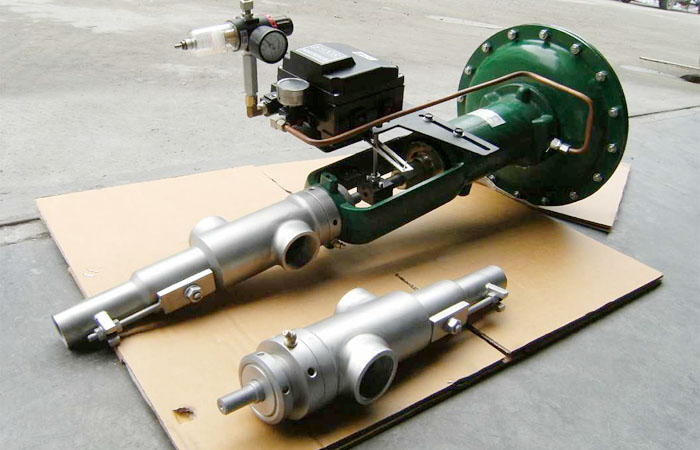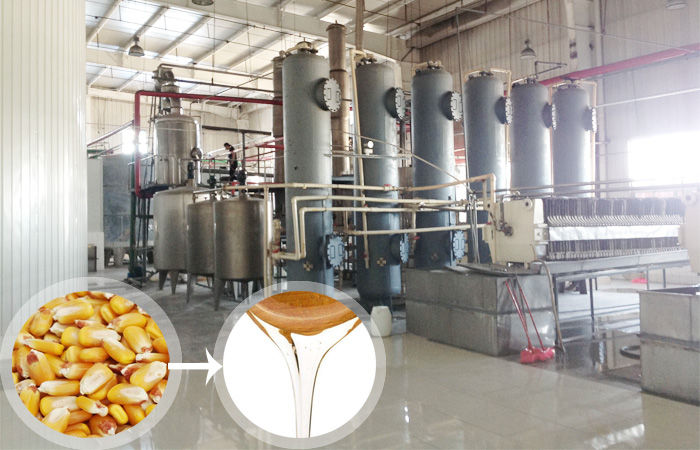Production of glucose syrup from cassava starch
2018-04-19
/Syrup Processing
Production of glucose syrup from cassava starch can be subdivided into the following process areas of liquefaction, saccharification, and purification. Of course, except these three process, also some others details processing of the production of glucose syrup from cassava starch. Firstly, you should understand that the production of glucose syrup, raw material usually starch, so as an abundant starch content grain, cassava and cassava starch also a good material for glucose syrup production.
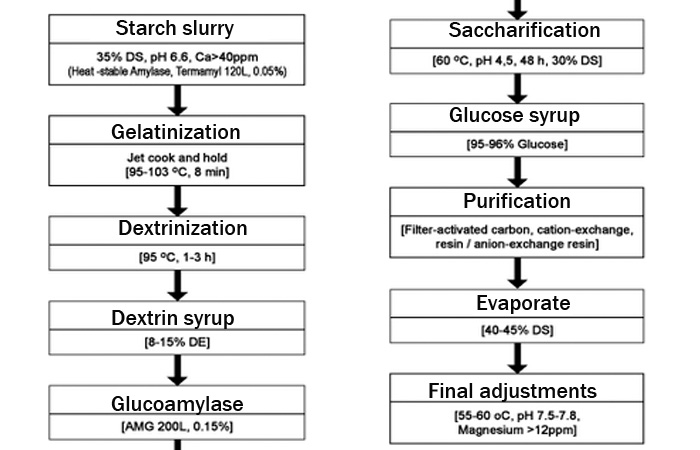
Production process of glucose syrup from cassava starch
Liquefaction:
Cassava starch slurry is made with 30-35% dry solids and adjust its PH value to 6.0-6.4. Calcium is added using calcium hydroxide or calcium chloride because calcium ions can stabilize the enzyme. A heat-stable α-amylase (Novo’s Termamyl 120L) is mixed into the cassava starch slurry, then the slurry is instantaneously heated to 100 ℃ and held at this temperature for 10 min before it is cooled to 90 ℃. This temperature is maintained for 1-3h to further hydrolyze the starch. Among this, it is the manufacturing process of liquefaction process in the production of glucose syrup from cassava starch.
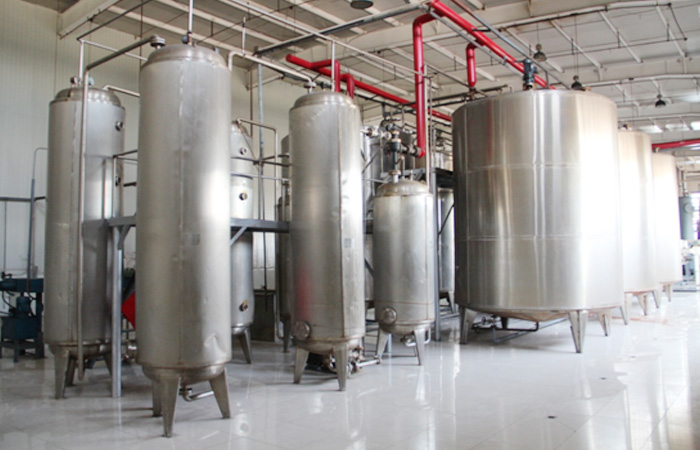
Equipments used for liquefaction
After this liquefying step complete, the starch has been transfered into dextrins with a dextrose equivalent (DE) between 8 and 15. (The physical properties of the syrup changed with the DE and the method of manufacture difference.) DE is the total reducing sugar in the syrup expressed as dextrose on a dry weight basis.
Saccharification:
After liquefaction, the pH is reduced to between 4.2 and 4.5 and the solution is cooled to 60 ℃. A glucomylase (Novo’s AMG 300L) is added immediately. The reaction time for saccharification is usually between 24-48 h depending on enzyme does. Glucoamylase releases single glucose units from the ends of dextrin molecule. Syrups of 95% glucose or higher are manufactured. This is the saccharification process for the production of glucose syrup from cassava starch.
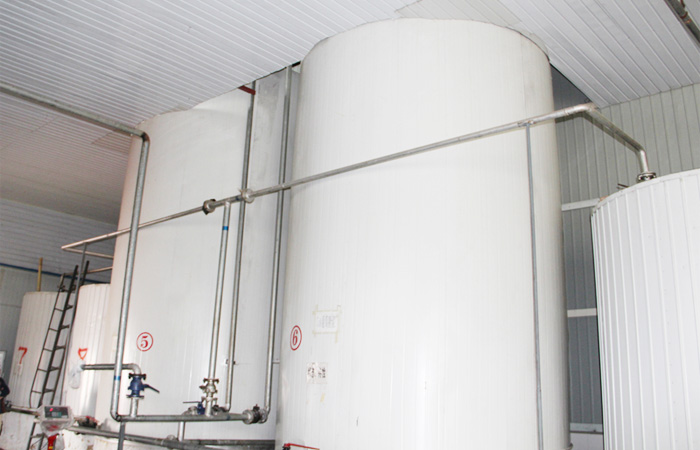
Saccharification tank
It's worth to tell you the liquefaction and saccharification step is the most important two parts of the glucose syrup production from glucose syrup. These steps performance influenced and decided the glucose products quality directly. So the advanced technology and equipments used for the production of glucose syrup from cassava starch select is very important.
Purification in the production of glucose syrup from cassava starch:
Purification step in the glucose syrup production is mean the last evaporating process to remove excess moisture from glucose, to get a standard concentration. On the other side, it also include the glucose syrup decolorization process, if you want to get colorless and transparent glucose, Doing Company plate and frame filter press can remove the color from syrup to meet your requests, if you don't request the glucose syrup colorless, don't need this. Purification process also include the ion exchange system for the production of glucose syrup from cassava starch, it's function is fully remove the ions to get pure syrup, widely used and suitable for all kinds of syrup production. By the way, this is the content in purification for the production of glucose syrup from cassava starch.
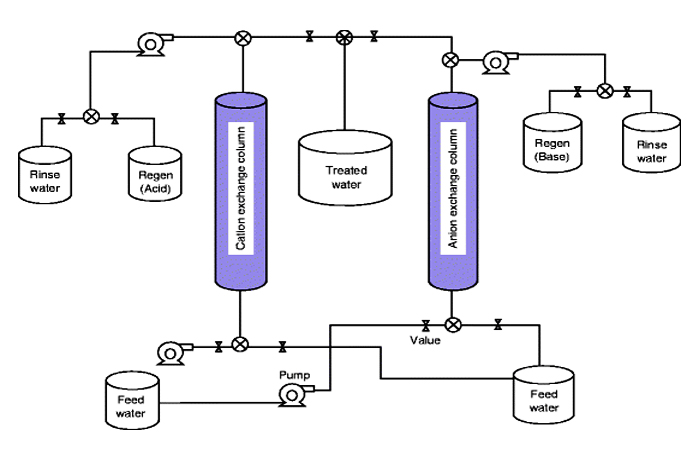
Purification ion exchange system working process
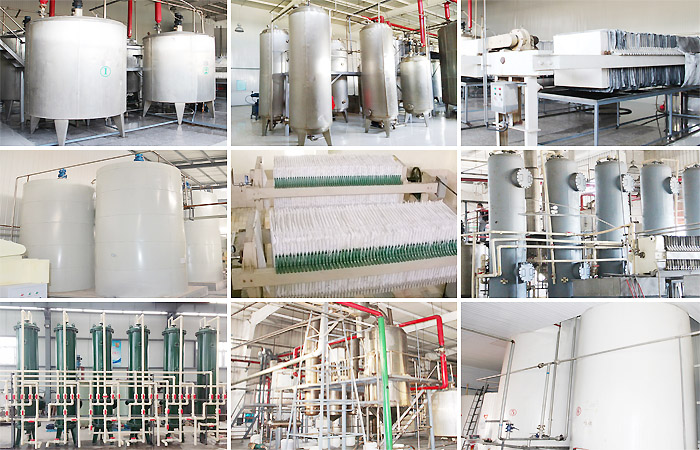
Production of glucose syrup from cassava starch used main equipments
For another, native starch consists of microscopic granules which with a complex internal structure. Under room temperature, these granules are insoluble in water. However, if a starch slurry is heated above 60 ℃, the granules will swell and rupture at last. This results in a dramatic increase in the cassava starch slurry viscosity. At this point, the cassava starch has been “gelatinized”. The gelatinized starch is now susceptible to attack by amylase enzymes. In practice, cassava starch in gelatinized and partially hydrolyzed very rapidly in one step (see flow chart) by heat-stable amylase. This step is called liquefaction. The partially degraded starch chains called dextrins are suitable starting materials for the later steps in syrup production. In above, this is the description of the enzyme method used for the production of glucose syrup from cassava starch, also the most advanced and newest method all over the world.

Production process of glucose syrup from cassava starch
Liquefaction:
Cassava starch slurry is made with 30-35% dry solids and adjust its PH value to 6.0-6.4. Calcium is added using calcium hydroxide or calcium chloride because calcium ions can stabilize the enzyme. A heat-stable α-amylase (Novo’s Termamyl 120L) is mixed into the cassava starch slurry, then the slurry is instantaneously heated to 100 ℃ and held at this temperature for 10 min before it is cooled to 90 ℃. This temperature is maintained for 1-3h to further hydrolyze the starch. Among this, it is the manufacturing process of liquefaction process in the production of glucose syrup from cassava starch.

Equipments used for liquefaction
Saccharification:
After liquefaction, the pH is reduced to between 4.2 and 4.5 and the solution is cooled to 60 ℃. A glucomylase (Novo’s AMG 300L) is added immediately. The reaction time for saccharification is usually between 24-48 h depending on enzyme does. Glucoamylase releases single glucose units from the ends of dextrin molecule. Syrups of 95% glucose or higher are manufactured. This is the saccharification process for the production of glucose syrup from cassava starch.

Saccharification tank
It's worth to tell you the liquefaction and saccharification step is the most important two parts of the glucose syrup production from glucose syrup. These steps performance influenced and decided the glucose products quality directly. So the advanced technology and equipments used for the production of glucose syrup from cassava starch select is very important.
Purification in the production of glucose syrup from cassava starch:
Purification step in the glucose syrup production is mean the last evaporating process to remove excess moisture from glucose, to get a standard concentration. On the other side, it also include the glucose syrup decolorization process, if you want to get colorless and transparent glucose, Doing Company plate and frame filter press can remove the color from syrup to meet your requests, if you don't request the glucose syrup colorless, don't need this. Purification process also include the ion exchange system for the production of glucose syrup from cassava starch, it's function is fully remove the ions to get pure syrup, widely used and suitable for all kinds of syrup production. By the way, this is the content in purification for the production of glucose syrup from cassava starch.

Purification ion exchange system working process

Production of glucose syrup from cassava starch used main equipments
For another, native starch consists of microscopic granules which with a complex internal structure. Under room temperature, these granules are insoluble in water. However, if a starch slurry is heated above 60 ℃, the granules will swell and rupture at last. This results in a dramatic increase in the cassava starch slurry viscosity. At this point, the cassava starch has been “gelatinized”. The gelatinized starch is now susceptible to attack by amylase enzymes. In practice, cassava starch in gelatinized and partially hydrolyzed very rapidly in one step (see flow chart) by heat-stable amylase. This step is called liquefaction. The partially degraded starch chains called dextrins are suitable starting materials for the later steps in syrup production. In above, this is the description of the enzyme method used for the production of glucose syrup from cassava starch, also the most advanced and newest method all over the world.
Leave A Message About Production of glucose syrup from cassava starch
- Director: Ms Elina Wu
- Phone: 0086 135 2661 5783
- WhatsApp: 0086 135 2661 5783
- Tel: 0086 371 5677 1822
- sales@syrupmachine.com
- Chat Online
- Ion exchange resin equiped in ion exchange column, its necessary for t...
- When high maltose corn syrup is produced in industrial production,the ...
- Here bellow introduces the sterilization and pollution prevention when...
- And we can install the corn syrup plant fou you.Corn syrup is produced...
- Corn syrup production steps introduce the way of how to make glucose s...
- The liquid glucose manufacturing process completed by one complete set...
- Corn syrup production process is a process of converting corn into syr...
- DOING adopt the modern and advanced technology for liquid syrup manufa...
- Starch syrup manufacturing process introductions and the main equipmen...
- Syrup evaporator is key equipment in glucose production line,there are...
